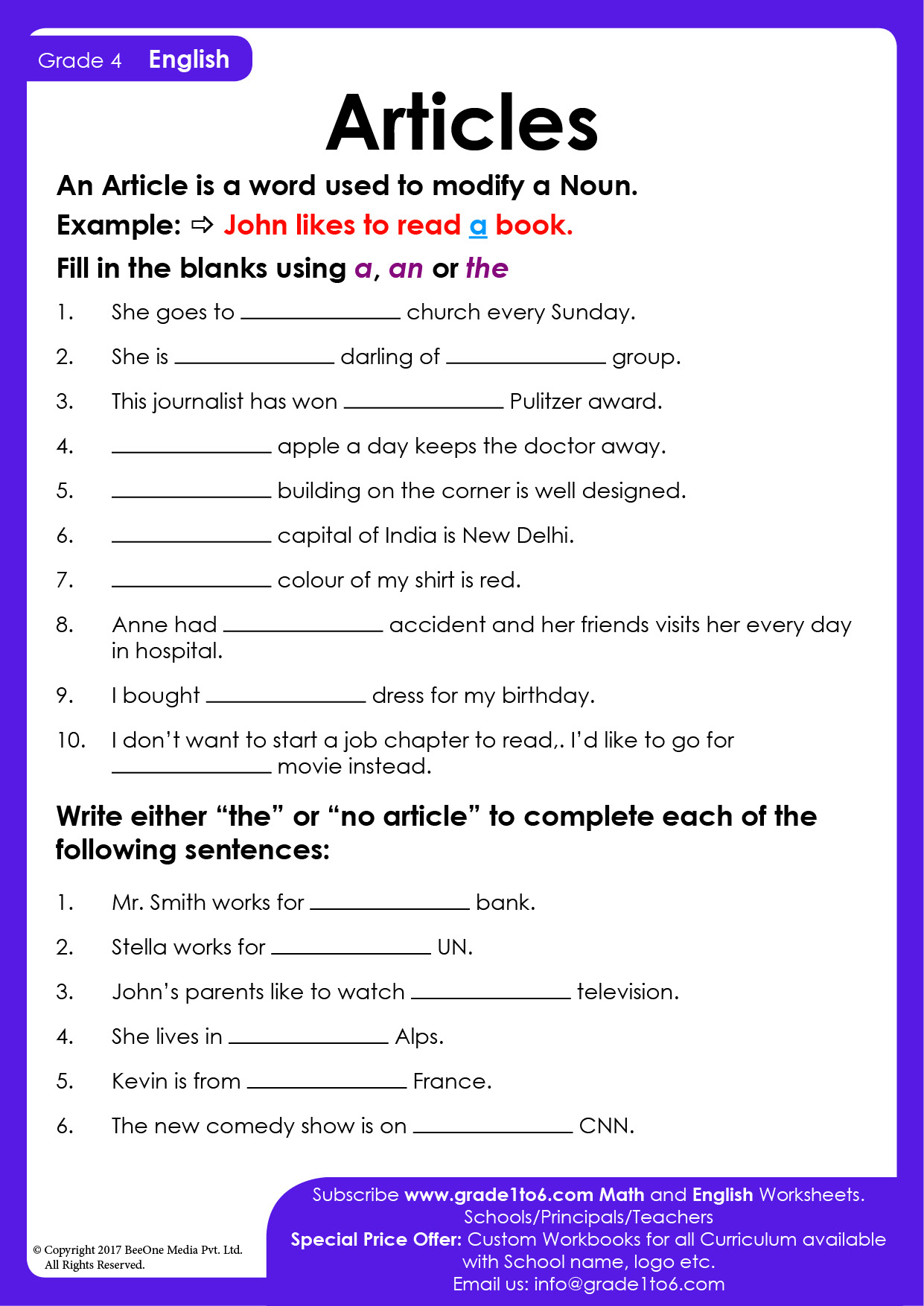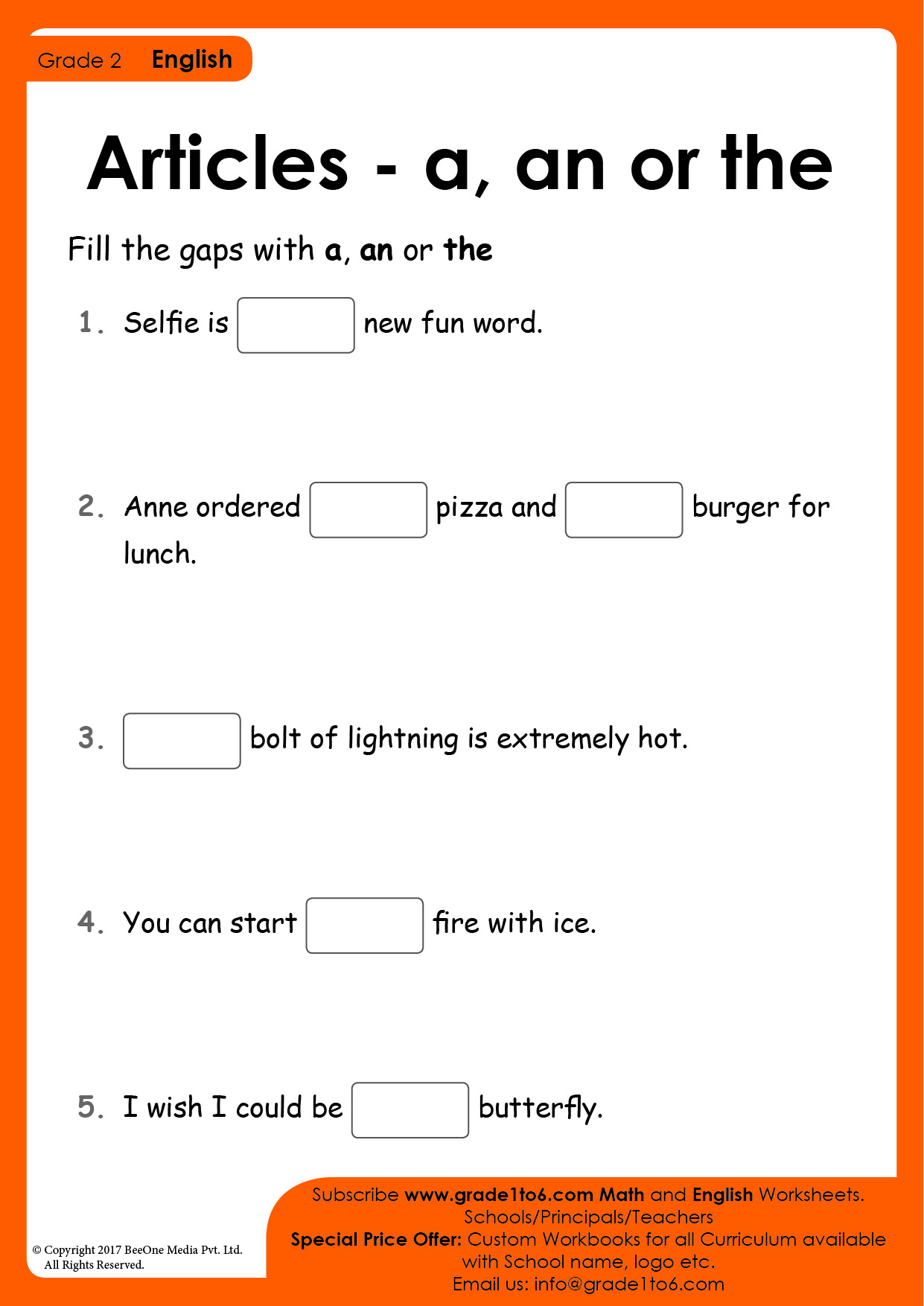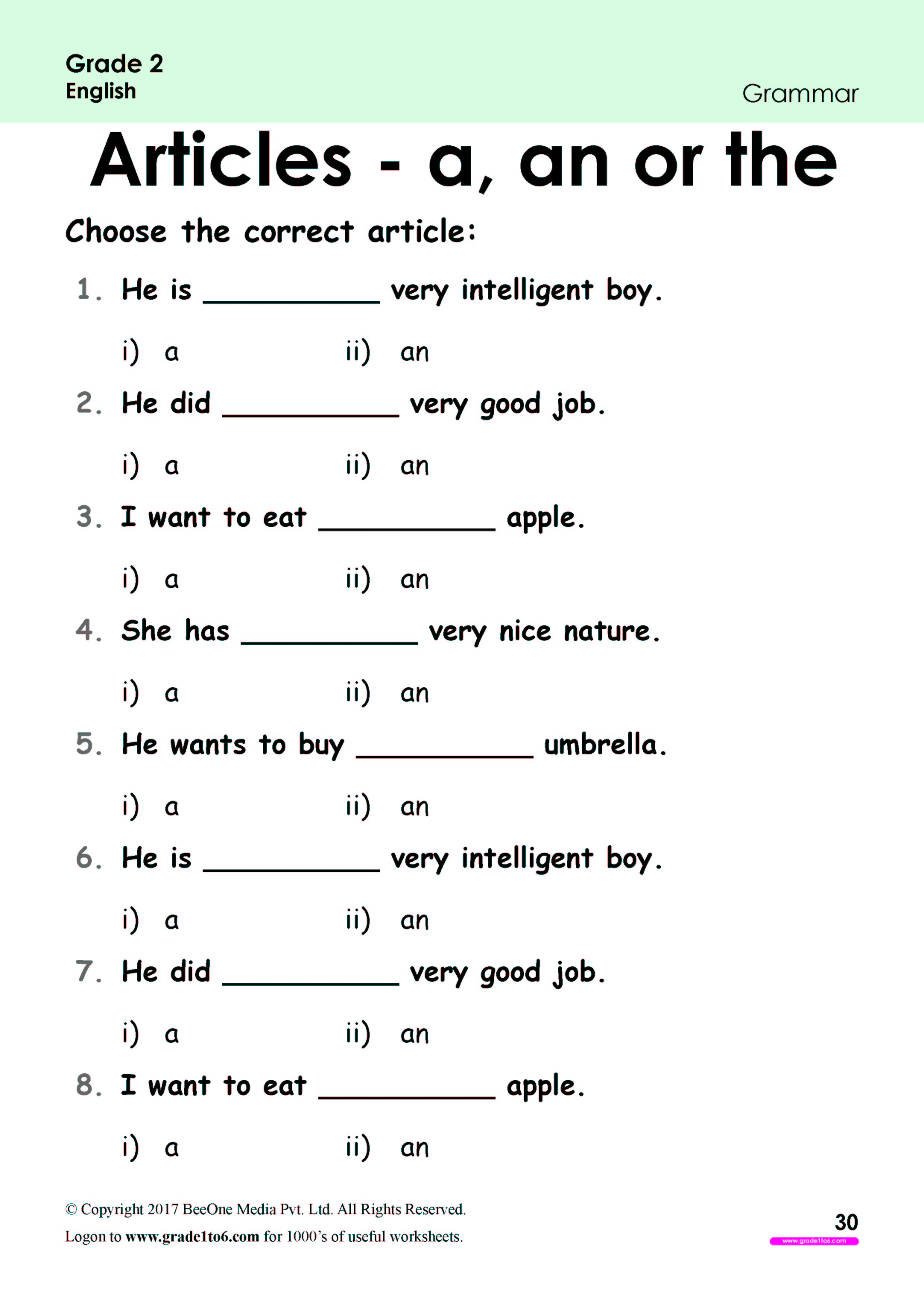
Mastering the Nuances of English: The Indispensable Role of Grammar Worksheets: Articles
English, with its vast vocabulary and intricate grammatical structures, presents a fascinating yet often challenging landscape for learners worldwide. Among its most subtle and frequently misused components are articles: "a," "an," and "the," alongside the concept of the "zero article." These tiny words, seemingly insignificant, carry immense weight in conveying precision, definiteness, and context. Their correct usage can elevate a sentence from merely understandable to perfectly natural and clear, while their misuse can lead to ambiguity or a distinctly non-native sound. This inherent complexity underscores the critical need for targeted, systematic practice. At the heart of this targeted approach are well-crafted Grammar Worksheets: Articles.
This comprehensive article will delve into the profound importance of articles in English, explore why they pose such a common hurdle for learners, and, most importantly, highlight how Grammar Worksheets: Articles serve as an indispensable tool in demystifying their rules, solidifying understanding, and ultimately fostering fluency and accuracy. We will discuss the various types of these worksheets, offer guidance on designing effective ones, and provide strategies for their optimal integration into both classroom instruction and self-study regimens.
The Enigma of Articles: Why They Pose a Challenge

Before exploring the solutions offered by worksheets, it’s crucial to understand the nature of the challenge. Articles in English function as determiners, preceding nouns to specify their identity or quantity.

- Indefinite Articles ("a," "an"): Used when referring to a non-specific or general noun, or when introducing a noun for the first time. "A" precedes words beginning with a consonant sound (e.g., a book, a university), while "an" precedes words beginning with a vowel sound (e.g., an apple, an hour).
- Definite Article ("the"): Used when referring to a specific noun that is already known to the listener/reader, or when there is only one of something, or when referring to a unique item. (e.g., the sun, the book I lent you).
- Zero Article: This refers to the absence of an article. It’s used with plural countable nouns or uncountable nouns when speaking generally (e.g., birds fly, water is essential), with proper nouns (e.g., Paris, Dr. Smith), and in certain fixed expressions.



The difficulty arises from several factors:
- Lack of Equivalents in Many Languages: Languages like Japanese, Korean, Russian, Mandarin Chinese, and many Slavic languages do not have direct equivalents for articles. Speakers of these languages often struggle to grasp the underlying conceptual framework, leading to omission or arbitrary insertion.
- Subtlety and Nuance: The rules governing article usage are not always black and white. There are numerous exceptions, idiomatic expressions, and subtle contextual distinctions that require extensive exposure and practice to master. For instance, "go to school" (general purpose) vs. "go to the school" (specific building).
- Regional Variations and Dialects: While standard rules exist, minor variations can sometimes be observed in different English-speaking regions, adding another layer of complexity for advanced learners.
- Overlapping Rules: Sometimes, a noun can take different articles depending on the precise context, requiring learners to make fine distinctions based on shared knowledge or previous mention.



These complexities make articles a persistent stumbling block, often marking the difference between a fluent speaker and one who, despite extensive vocabulary, sounds slightly "off." This is where the structured, repetitive, and targeted practice offered by worksheets becomes invaluable.
The Power of Grammar Worksheets: Articles

This is where Grammar Worksheets: Articles truly shine. A grammar worksheet, in this context, is a structured exercise designed to provide focused practice on a specific grammatical point. For articles, these worksheets offer numerous benefits:
- Targeted Practice: Unlike general reading or conversation, worksheets isolate article usage, allowing learners to concentrate solely on applying the rules without being overwhelmed by other grammatical challenges.
- Reinforcement and Repetition: Mastery comes through repetition. Worksheets provide ample opportunities to apply the rules multiple times in various contexts, embedding them more deeply in the learner’s memory.
- Immediate Feedback: Many worksheets come with answer keys, allowing learners to self-correct and understand their mistakes instantly. This immediate feedback loop is crucial for effective learning, preventing the reinforcement of errors.
- Confidence Building: Successfully completing exercises builds confidence. As learners see their accuracy improve, they become more motivated to tackle more complex aspects of English grammar.
- Structured Learning Path: Worksheets can be designed to progress from simpler concepts (e.g., basic a/an vs. the) to more complex ones (e.g., zero article, exceptions), providing a clear and manageable learning path.
- Diagnostic Tool: For educators, worksheets serve as excellent diagnostic tools, quickly identifying areas where students struggle collectively or individually, allowing for tailored instruction.
- Supplement to Broader Learning: While not a replacement for immersive language exposure, worksheets effectively supplement reading, listening, speaking, and writing by providing a focused environment for rule application.
Types of Grammar Worksheets: Articles
The variety available in Grammar Worksheets: Articles caters to diverse learning styles and proficiency levels, ensuring that practice remains engaging and effective. Here are some common types:
-
Fill-in-the-Blanks:
- Description: Sentences with blanks where learners must insert the correct article (a, an, the, or X for zero article).
- Example: "I saw cat. cat was chasing ___ mouse."
- Benefit: Excellent for beginners, focusing on basic application of rules.
-
Multiple Choice:
- Description: Sentences with options for articles, requiring learners to select the best fit.
- Example: "He went to (a/an/the/X) hospital."
- Benefit: Good for testing understanding of subtle distinctions and quick recall.
-
Error Correction:
- Description: Sentences or short paragraphs containing errors in article usage, which learners must identify and correct.
- Example: "He bought new car yesterday. The car is red." (Correction: "He bought a new car yesterday. The car is red.")
- Benefit: Develops critical thinking and attention to detail, mirroring real-world editing.
-
Sentence Transformation:
- Description: Learners rewrite sentences, changing specificity or generality, thus requiring article changes.
- Example: "I read a book." (Transform to refer to a specific book: "I read the book you recommended.")
- Benefit: Encourages deeper understanding of how context dictates article choice.
-
Contextual/Passage-Based Exercises:
- Description: Longer texts (paragraphs, short stories) with blanks or errors, forcing learners to consider article usage within a broader narrative.
- Benefit: Mimics real-world reading and writing, emphasizing the importance of discourse context.
-
Role-Playing/Dialogue Prompts:
- Description: While not strictly "worksheets," these can be structured activities that prompt learners to use articles in spoken contexts.
- Example: "Describe your last trip, making sure to use ‘a,’ ‘an,’ and ‘the’ correctly."
- Benefit: Bridges the gap between written practice and spontaneous spoken production.
-
Matching Exercises:
- Description: Match a noun phrase with the correct article rule explanation, or match sentences with the correct article applied.
- Benefit: Reinforces understanding of the rules themselves, not just their application.
-
Interactive Digital Worksheets:
- Description: Online exercises often incorporating gamification, instant feedback, and multimedia.
- Benefit: Engaging, accessible, and provides immediate assessment without manual grading.
Designing Effective Grammar Worksheets: Articles
Not all worksheets are created equal. To maximize their efficacy, designers (whether teachers or self-learners adapting materials) should consider the following principles:
- Clear Instructions: Ambiguous instructions can frustrate learners. Ensure they know exactly what is expected.
- Gradual Difficulty: Start with simpler concepts and progressively introduce more complex rules and exceptions. Scaffolding is key.
- Variety of Exercise Types: Mix and match the types mentioned above to keep learners engaged and address different learning styles.
- Relevant Context: Use sentences and scenarios that are relatable and interesting to the target audience. Abstract sentences are less engaging.
- Authentic Language: While simplified for beginners, sentences should still sound natural and reflect real-world English usage.
- Ample Practice: Ensure there are enough items for learners to internalize the rules, but not so many that they become monotonous.
- Clear Answer Key: A well-organized answer key is crucial for self-correction and understanding. Provide explanations for tricky cases if possible.
- Visual Appeal: A clean, uncluttered layout with appropriate spacing can significantly enhance readability and reduce cognitive load.
- Target Audience Consideration: Design worksheets specifically for beginners, intermediate, or advanced learners, as their needs and common errors differ.
Implementing Grammar Worksheets: Articles in Learning
Effective implementation of Grammar Worksheets: Articles can significantly accelerate the learning process, whether in a classroom setting or for individual study.
For Educators:
- Warm-ups/Bell Ringers: Quick article exercises at the beginning of a lesson can activate prior knowledge and set the stage.
- Homework Assignments: Reinforce classroom learning and provide independent practice.
- Formative Assessment: Use worksheets to gauge student understanding before moving on to new topics.
- Remedial Work: Assign specific worksheets to students struggling with particular article rules.
- Interactive Sessions: Turn worksheet completion into a collaborative activity, with students discussing their answers and reasoning.
- Error Analysis: Don’t just grade; discuss common errors, explain the underlying rules again, and provide opportunities for re-practice.
For Self-Learners:
- Consistent Practice: Dedicate regular, short sessions to article worksheets rather than sporadic long ones.
- Self-Correction with Understanding: Don’t just copy answers. Understand why an answer is correct or incorrect. Refer back to grammar rules.
- Supplement with Other Resources: Use worksheets alongside grammar textbooks, online tutorials, and video lessons.
- Track Progress: Keep a record of scores or challenging areas to see improvement over time and identify persistent difficulties.
- Integrate with Productive Skills: After completing a worksheet, try to consciously apply the learned rules in your own speaking and writing.
Beyond the Worksheet: Integrating Article Mastery
While Grammar Worksheets: Articles are an invaluable tool, they are just one component of a holistic language learning strategy. True mastery of articles comes from integrating the knowledge gained from worksheets into real-world communication.
- Extensive Reading: Reading authentic English materials (books, articles, news) exposes learners to correct article usage in natural contexts. Pay conscious attention to how articles are used.
- Active Listening: Notice article usage in podcasts, movies, and conversations. How do native speakers use "a," "an," and "the"?
- Conscious Speaking Practice: When speaking, make a deliberate effort to apply article rules. Don’t be afraid to self-correct.
- Reflective Writing: After writing, review your work specifically for article errors. Use grammar checkers, but also train your eye to spot mistakes.
- Seek Feedback: Ask native speakers or proficient learners to correct your article usage in conversation or written work.
Challenges and Considerations
Despite their numerous benefits, there are some considerations when relying heavily on article worksheets:
- Over-reliance: Worksheets should complement, not replace, exposure to authentic language and communicative practice.
- Lack of Context for Some Rules: While contextual worksheets exist, some isolated fill-in-the-blank exercises might not fully convey the nuances of certain article rules that depend heavily on discourse.
- Boredom/Monotony: Repetitive exercises can become tedious if not varied or balanced with other activities.
- No Substitute for Human Interaction: A worksheet cannot provide the dynamic feedback and personalized explanations that a teacher or tutor can offer in response to complex questions.
Conclusion
Articles in English are small words with monumental impact, defining the clarity and naturalness of communication. Their mastery is a hallmark of advanced English proficiency, yet they remain a persistent challenge for learners from diverse linguistic backgrounds. Grammar Worksheets: Articles stand as an indispensable tool in overcoming this hurdle. By providing targeted, repetitive, and structured practice, they demystify complex rules, reinforce understanding, and build the confidence necessary for learners to apply these rules instinctively.
From basic fill-in-the-blanks to advanced error correction, the diverse range of these worksheets caters to every stage of the learning journey. When effectively designed with clear instructions, varied exercises, and relevant contexts, and when integrated thoughtfully into a broader learning strategy that includes extensive reading, listening, speaking, and writing, Grammar Worksheets: Articles can transform a learner’s struggle into a triumph. They are not merely exercises but stepping stones towards achieving true fluency, precision, and a natural command of the English language. Embracing these tools is a crucial step for anyone aiming to speak and write English with native-like accuracy and confidence.
